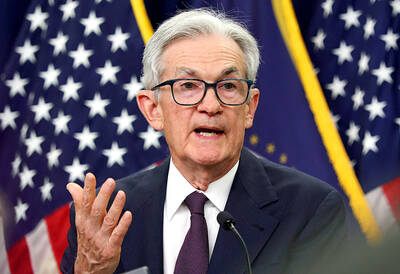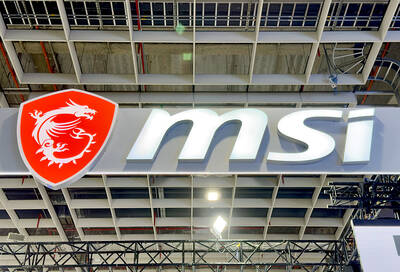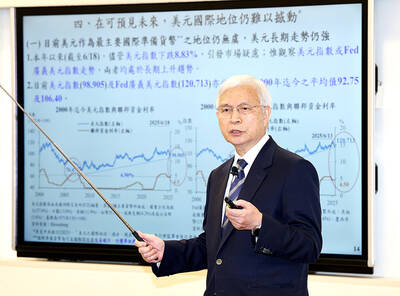Harley-Davidson plans to shift some manufacturing of its iconic motorcycles overseas to avoid retaliatory European tariffs imposed last week, the company said on Monday.
The announcement comes as the company, founded in the early 1900s, is also buffeted by higher steel costs following tariffs enacted by US President Donald Trump, who had embraced the company as an emblematic US industrial firm in the early days of his administration.
The US president expressed disappointment.

Photo: AFP
“Surprised that Harley-Davidson, of all companies, would be the first to wave the White Flag,” Trump tweeted.
“I fought hard for them and ultimately they will not pay tariffs selling into the EU, which has hurt us badly on trade, down US$151 Billion. Taxes just a Harley excuse — be patient!” he wrote.
Harley-Davidson suggested it had no choice after the EU on Friday hit US motorcycles with duties of 31 percent, up from 6 percent, boosting the cost to EU consumers by about US$2,200.
The EU targeted the US vehicles as part of its rebuttal to Trump’s tariffs on imported aluminum and steel, one aspect of his multifront trade war.
Moving production overseas is expected to require nine to 18 months, so in the near term, Harley-Davidson will absorb the costs of EU tariffs, the company said in a regulatory notice.
That would add an estimated US$90 million to US$100 million annually.
“Increasing international production to alleviate the EU tariff burden is not the company’s preference, but represents the only sustainable option to make its motorcycles accessible to customers in the EU and maintain a viable business in Europe,” the company said.
Some analysts expect to see more instances of company shifts in supply chain or manufacturing venues due to trade tariffs when the second-quarter earnings season starts early next month.
Harley-Davidson currently has overseas manufacturing plants in Australia, Brazil and India. It is building a plant in Thailand.
The company did not specify where the additional manufacturing would go.
“We are currently assessing the potential impact on our US facilities,” Harley-Davidson spokesman Michael Pflughoeft said. “We are hopeful the US and EU governments will continue to work together to reach an agreement on trade issues and rescind these tariffs.”
On Wall Street, Harley-Davidson shares dropped sharply 5.97 percent on Monday.
Harley-Davidson has been relying on Europe and other international markets to help offset declining sales in the US, where the baby boomers who have long bought the vehicles are aging and younger consumers are not taking to the motorcycles in a big way.
In the first quarter, retail sales of motorcycles fell 12 percent in the US, but rose nearly 7 percent in the European, Middle East and Africa region.
In the wake of the sluggish US sales, Harley-Davidson in January announced that it would close its Kansas City, Missouri, assembly plant and consolidate jobs in York, Pennsylvania.
Adding to the difficulty facing the company were steel and aluminum tariffs on the EU, Canada and Mexico finalized by the Trump administration early this month.
Chief financial officer John Olin told analysts in April he expected the tariffs to add US$15 million to US$20 million “on top of already rising raw materials,” representing “quite a headwind for the company over the next several quarters.”

DIVIDED VIEWS: Although the Fed agreed on holding rates steady, some officials see no rate cuts for this year, while 10 policymakers foresee two or more cuts There are a lot of unknowns about the outlook for the economy and interest rates, but US Federal Reserve Chair Jerome Powell signaled at least one thing seems certain: Higher prices are coming. Fed policymakers voted unanimously to hold interest rates steady at a range of 4.25 percent to 4.50 percent for a fourth straight meeting on Wednesday, as they await clarity on whether tariffs would leave a one-time or more lasting mark on inflation. Powell said it is still unclear how much of the bill would fall on the shoulders of consumers, but he expects to learn more about tariffs

Meta Platforms Inc offered US$100 million bonuses to OpenAI employees in an unsuccessful bid to poach the ChatGPT maker’s talent and strengthen its own generative artificial intelligence (AI) teams, OpenAI CEO Sam Altman has said. Facebook’s parent company — a competitor of OpenAI — also offered “giant” annual salaries exceeding US$100 million to OpenAI staffers, Altman said in an interview on the Uncapped with Jack Altman podcast released on Tuesday. “It is crazy,” Sam Altman told his brother Jack in the interview. “I’m really happy that at least so far none of our best people have decided to take them

PLANS: MSI is also planning to upgrade its service center in the Netherlands Micro-Star International Co (MSI, 微星) yesterday said it plans to set up a server assembly line at its Poland service center this year at the earliest. The computer and peripherals manufacturer expects that the new server assembly line would shorten transportation times in shipments to European countries, a company spokesperson told the Taipei Times by telephone. MSI manufactures motherboards, graphics cards, notebook computers, servers, optical storage devices and communication devices. The company operates plants in Taiwan and China, and runs a global network of service centers. The company is also considering upgrading its service center in the Netherlands into a

NOT JUSTIFIED: The bank’s governor said there would only be a rate cut if inflation falls below 1.5% and economic conditions deteriorate, which have not been detected The central bank yesterday kept its key interest rates unchanged for a fifth consecutive quarter, aligning with market expectations, while slightly lowering its inflation outlook amid signs of cooling price pressures. The move came after the US Federal Reserve held rates steady overnight, despite pressure from US President Donald Trump to cut borrowing costs. Central bank board members unanimously voted to maintain the discount rate at 2 percent, the secured loan rate at 2.375 percent and the overnight lending rate at 4.25 percent. “We consider the policy decision appropriate, although it suggests tightening leaning after factoring in slackening inflation and stable GDP growth,”